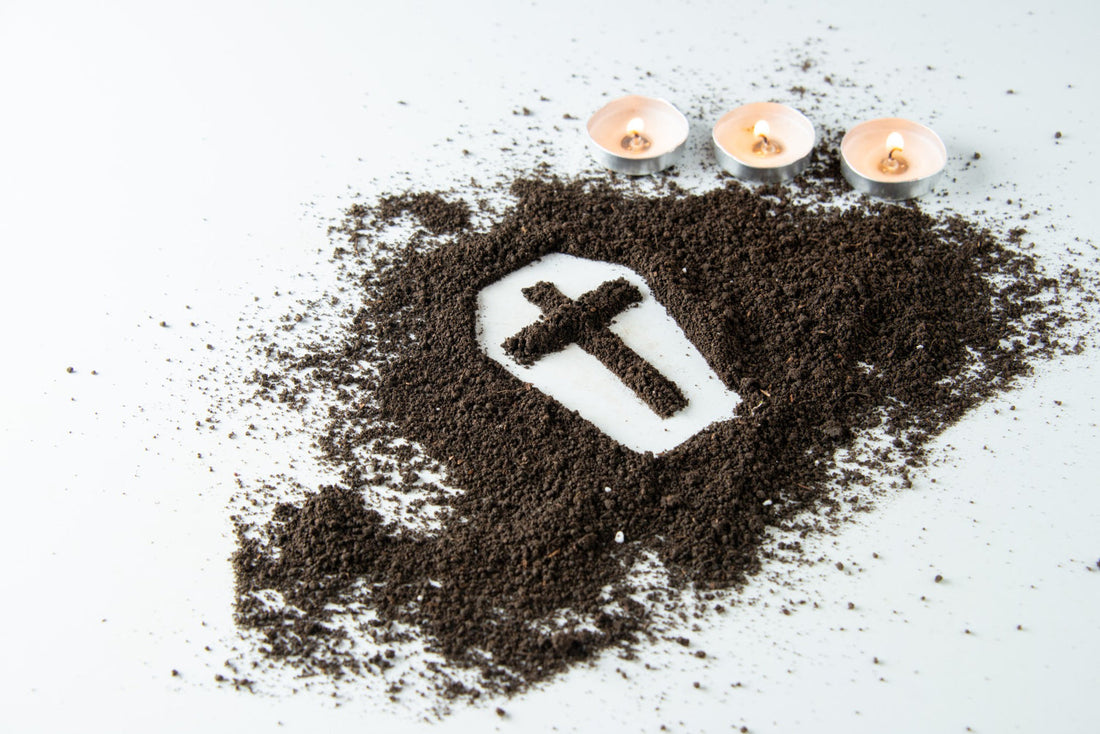
Facts About Cremation Ashes: Myths, Meaning & Common Questions
Share
Cremation has become one of the most popular choices for families across the world. But while many are familiar with the process, there are still countless myths, questions, and curiosities about cremation ashes—from their composition to their spiritual meaning.
Families often ask: What don’t they tell you about cremation? What color are human ashes after cremation? Do cremated ashes have energy? Is it bad luck to keep ashes in the house? This article explores these questions and more, offering both scientific and spiritual perspectives so you can make informed choices.
What Are Cremation Ashes?
Cremation ashes, also called cremated remains, are what is left after the cremation process. Despite the name “ashes,” they are actually ground bone fragments processed into a fine, sand-like material.
The average adult yields 4 to 8 pounds (1.8 to 3.6 kg) of ashes, depending on body size and bone density. These remains are then placed in a container or urn for ashes and returned to the family.
What Don’t They Tell You About Cremation?
Many families are surprised to learn details about the cremation process and the nature of ashes. Some lesser-known facts include:
- Ashes Are Not Dust, But Bone Fragments – The cremation process burns away soft tissue, leaving only bones, which are then ground into the ashes you receive.
- Medical Implants Are Removed – Pacemakers, artificial hips, and metal screws are separated before or after cremation to avoid damage to equipment.
- Ash Weight Varies – Larger bone mass produces heavier remains; it’s not about body fat or weight at time of death.
- No Fire Touches the Body – Modern cremation uses intense heat, not flames, to reduce the body to bone fragments.
- Ashes Are Sterile – Cremation ashes are completely safe to handle and do not carry disease.
These are the things “they don’t always tell you about cremation,” but knowing them can help families feel reassured and informed.
What Actually Remains in the Ashes After Cremation?
The question of what actually remains in cremation ashes is common. Scientifically, the ashes primarily consist of:
- Calcium phosphates (from bones)
- Minerals like potassium and sodium
- Trace amounts of metals (if implants remain)
Soft tissues, organs, and fluids are completely vaporized in the process. What’s returned to families are the purified, processed bone fragments.
What Color Are Human Ashes After Cremation?
Families are often curious: What color are human ashes after cremation?
- Typically, cremated remains are gray to light white.
- The exact shade depends on bone composition, age, and even the cremation chamber.
- Some ashes may appear with a slight bluish or brownish tint due to mineral content.
So, while the image of black soot-like ashes is common in movies, real cremation ashes are much lighter in color and texture.
Do Cremated Ashes Have Energy?
Spiritually and emotionally, many people feel that cremation ashes carry energy. Scientifically, ashes themselves are inert—they no longer contain biological life.
However, in the realm of spirituality and metaphysics, some traditions believe:
- Ashes retain the soul’s essence or energy, serving as a symbolic connection.
- In Hinduism and Buddhism, ashes may represent the transformation of life into spirit.
- Some energy healers believe ashes can hold vibrations tied to the deceased’s spirit.
Whether viewed scientifically as matter or spiritually as energy, ashes undeniably hold profound meaning for families.
What Does God Say About Keeping Ashes?
A common concern is: What does God say about keeping ashes?
- The Bible does not explicitly forbid cremation or keeping ashes. Burial was the common tradition, but cremation is not condemned.
- Catholic Church – Since 1963, the Church has allowed cremation, but prefers ashes to be kept in a sacred place (like a cemetery niche) rather than scattered or stored at home.
- Protestant and Evangelical Views – Most accept cremation and believe God can resurrect the body regardless of its form.
- Other Faiths – Hinduism and Buddhism encourage cremation, while Islam and Orthodox Judaism generally prohibit it.
So, while some religious traditions advise against keeping ashes at home, others permit it with reverence.
Is It Bad Luck to Keep Ashes in the House?
Cultural beliefs vary widely. Some people ask: Is it bad luck to keep ashes in the house?
- In Feng Shui traditions, keeping ashes indoors is believed to disrupt energy balance.
- Some cultures fear that ashes may attract spirits or create restless energy.
- Others view keeping ashes at home as a way of preserving closeness and love, not bad luck.
Ultimately, whether ashes bring peace or discomfort depends on personal belief. Many families feel comforted by keeping an urn at home, while others prefer scattering ashes in nature or placing them in a memorial site.
Memorial Options: What Can Be Done With Cremation Ashes?
Families today have more choices than ever for honoring their loved ones. Beyond storing in a traditional urn, options include:
- Scattering Ashes – In nature, gardens, or special locations (check local laws).
- Memorial Jewelry – Infusing ashes into pendants, rings, or bracelets.
- Keepsake Urns – Smaller cremation urns allow ashes to be shared among family members.
- Burial of Ashes – In a cemetery plot or columbarium.
- Creative Memorials – Incorporating ashes into glass art, fireworks, or even tree planting urns.
These practices allow families to balance tradition, creativity, and spiritual meaning.
Quick FAQs About Cremation Ashes
What Don’t They Tell You About Cremation?
Ashes are ground bone fragments, not dust. Medical implants are removed, and the remains are completely sterile.
What Does God Say About Keeping Ashes?
The Bible doesn’t prohibit keeping ashes. Many Christian denominations allow cremation, though Catholic tradition prefers ashes to be in sacred places.
What Actually Remains in the Ashes After Cremation?
Primarily bone minerals like calcium, phosphates, and trace elements.
Do Cremated Ashes Have Energy?
Scientifically inert, but spiritually many cultures believe ashes retain symbolic or vibrational energy.
Is It Bad Luck to Keep Ashes in the House?
Some traditions say yes, but many families find comfort in keeping ashes at home.
What Color Are Human Ashes After Cremation?
Ashes are usually gray to light white, sometimes with slight brown or bluish tones.
Conclusion: The Meaning Behind Cremation Ashes
Understanding facts about cremation ashes helps dispel myths and provides clarity during grieving. From their composition to spiritual significance, ashes are more than remains—they are symbols of life, memory, and transformation.
Whether families choose to keep them at home, bury them, or scatter them, cremation ashes serve as a lasting connection to those we love. By exploring questions like what actually remains in ashes, what does God say about keeping them, and whether ashes carry energy, we can better appreciate both the science and spirituality behind cremation.
For some, ashes are simply matter; for others, they hold energy, luck, and eternal remembrance. Either way, they represent love that endures beyond death.
